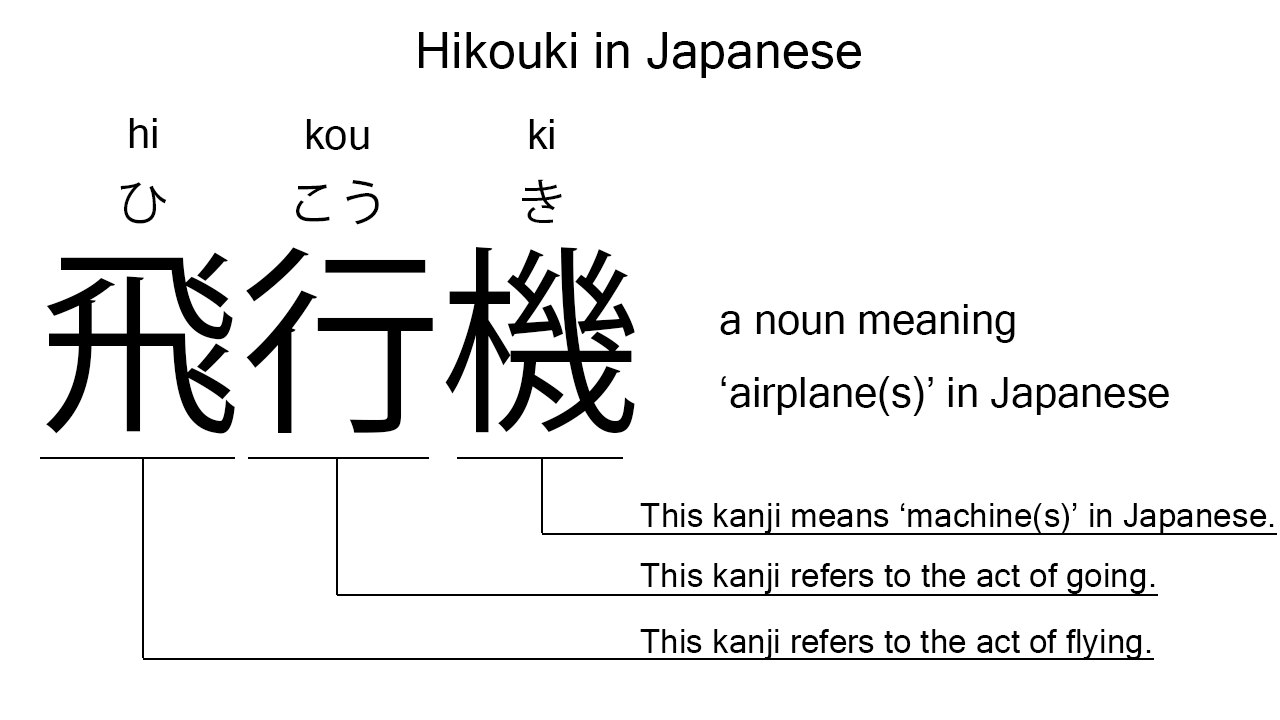What does “hikouki” mean in Japanese?
Native speakers say “hikouki” to mean ‘airplane’ in Japanese. Perhaps, some Japanese learners know this word as it is sometimes used in Japanese conversations. In this blog post, however, I will explain it in detail based on its kanji expression. And also, I will explain how to use it through example sentences. My explanations would help Japanese learners understand “hikouki” more clearly. Then, let’s get started!
Contents
Definition and meanings of “hikouki”
Let me start with the definition and meanings of “hikouki”.
- hikouki – 飛行機 (ひこうき) : a noun meaning ‘airplane’, ‘aeroplane’, or ‘aircraft’ in Japanese. This can also work as plural. Learn more about Japanese plural.
The definition and meanings are simple and clear. To understand this noun more clearly, however, let me explain its kanji characters in detail, one by one.
What does “hikouki” literally mean in Japanese?
The kanji expression of “hikouki” consists of the following three kanji characters:
- 飛 : a kanji character often used to refer to the act of flying. This can also be found in other words like “tobu“.
- 行 : a kanji character often used to refer to the act of going. This can also be found in other words like “iku“.
- 機 : a kanji character often used to mean ‘machine’, ‘machines’, or ‘machinery’ in Japanese.
From these three kanji characters, we can understand that “hikouki” literally means ‘a machine to fly and go with’ in Japanese. This literal interpretation is very close to the actual meanings. Airplanes are indeed machines to fly and go with.

When we meet new kanji expressions, we should check their kanji characters in detail to understand their meanings clearly and deeply. In many cases, kanji characters tell us a lot about the meanings of the expressions they form. Actually, here, we could get the better understanding of “hikouki” through the detailed kanji check above.
So far, I’ve explained the definition and meanings of “hikouki” together with its kanji characters. Then, let me explain how to use it through the example sentences below.
Example #1: how to say “airplane” in Japanese
watashi tachi wa hikouki de tokyo made iku – 私達は飛行機で東京まで行く (わたしたちはひこうきでとうきょうまでいく)
We will go to Tokyo by airplane.
Below are the new words used in the example sentence.
- watashi – 私 (わたし) : a pronoun meaning ‘I’ in Japanese.
- tachi – 達 (たち) : a suffix used after a noun or pronoun to make its plural form. In the example, this is used after “watashi” to make its plural form, “watashi tachi”, which means ‘we’ in Japanese.
- wa – は : a binding particle working as a case marker or topic marker. In the example, this works after “watashi tachi” to make the subject in the sentence.
- de – で : a case particle used to say what means someone uses to do something. In the example, this is used after “hikouki” to indicate the means which the speakers use to go to Tokyo.
- tokyo – 東京 (とうきょう) : a noun meaning ‘Tokyo’ in Japanese.
- made – まで : an adverbial particle used to indicate a destination. In the example, this is used after “tokyo” to indicate the destination.
- iku – 行く (いく) : a verb meaning ‘to go’ in Japanese.
This is a typical usage of “hikouki”. In the example, it works together with “de” to indicate the means which the speakers use to go to Tokyo. The combination, “hikouki de”, is often translated into English as ‘by airplane’ or just ‘by plane’. It’s worth knowing, I think.
Example #2: another usage of “hikouki”
hikouki ga yure te iru – 飛行機が揺れている (ひこうきがゆれている)
The airplane is shaking.
Below are the new words used in the example sentence.
- ga – が : a case particle used to make the subject word or the object word in a sentence. In the example, this is used after “hikouki” to make the subject in the sentence.
- yure – 揺れ (ゆれ) : one conjugation of the verb, “yureru”, which means ‘to shake’ in Japanese. In the example, it has been conjugated for the better connection with its following word.
- te – て : a conjunctive particle used after a verb, adjective, or auxiliary verb to make its te form. In the example, this is used after “yure” to make its te form, “yure te”. Verbs need to be changed to their te forms to be connected with “iru”.
- iru – いる : an auxiliary verb used to express the continuity of the action described by its preceding verb. In the example, this is used after the te-formed verb, “yure te”, to express the continuity of the action, ‘to shake’.
This is another typical usage of “hikouki”. In this example, it works together with the case particle, “ga”, to become the subject in the sentence. When we want to say “airplane” in Japanese, anyway, this noun is always a very good option.
Summary
In this blog post, I’ve explained the definition and meanings of “hikouki” in detail based on its kanji expression. And also, I’ve explained how to use it through the example sentences. Let me summarize them as follows.
- hikouki – 飛行機 (ひこうき) : a noun meaning ‘airplane’, ‘aeroplane’, or ‘aircraft’ in Japanese. This can also work as plural. These three kanji characters literally mean ‘a machine to fly and go with’ in Japanese. This literal interpretation is very close to the actual meanings. Airplanes are indeed machines to fly and go with.
Hope my explanations are understandable and helpful for Japanese learners.